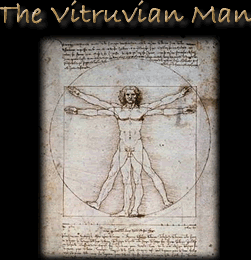BACKGROUND | TASK | PRESENTATION | CURRICULUM OBJECTIVES | RUBRICS
|
Who the heck is Vitruvius... The reverse writing imbedded in Leonardo’s drawing is his translation into Italian from the Latin of MARCUS VITRUVIUS POLLIO, De Architectura, Book III of X, Chapter 1, "On Symmetry in Temples and in the Human Body." Vitruvius, an architect and military engineer during the Second Triumvirate, (following the death of Julius Caesar) and in the early reign of Augustus, was strongly influenced by the Greeks, particularly Hermogenes (c.200 BCE), and wrote on topics of style, proportion, ornamentation, the directions of streets, foundations and substructures, building methods and materials, ancient inventions, acoustics, and structural harmonics. Vitruvius
wrote, |
|
Students will create their own version of the Vitruvian Man and will relate Vitruvius' theories of proportions to their model. What follows is detailed instructions to help guide students through the work. With a partner and a digital camera locate an adult male and photograph him in the positions described below...
Once you have acquired the images needed, determine if the following ten statements are true. The preceding
is the complete translation of the text accompanying Leonardo DaVinci's
Vitruvian Man. It is actually a translation of Vitruvius, as Leonardo's
drawing was originally an illustration for a book on the works of Vitruvius.
|
|
At the point in the school year that this project will be presented, we will have explored many different presentation styles open to the students. It is our belief that different students will excel in different styles and we want students to be able to design thir finished work in a manner that best reflects their work. Upon completion of your calculations show these 10 ratios and statements on your newly created Viruvian Man. Your final project can be presented in any form you deem suitable for the work that you created. Be sure to include answers to the following questions in your final presentation:
We have presented our finished task as a webpage. View finished project. Extension Activities:
|
|
MATH
|
ART
|
ICT
|
|
|
|
| 1 |
|
| 2 |
|
| 3 |
|
| 4 |
|
|
During the project presentation and peer assessment, we asked the following questioned and received this feedback. 1) This website was designed for our personal use, to help guide us in further planning when we actually teach this unit (hopefully) next year. Do you think that this site would be a helpful resource for other grade 6 teachers? Grade 6 students? How could we add to it or change it to make it better for others to use it as a resource?
2) One of our goals in creating this website and unit was to explore the ideas of Leonardo in ways that he would have done so- by studying, comparing, seeing and knowing to find the interconnectedness of the world. Do you think that we were successful in finding these connections? Would grade 6 students be able to see these relationships after going through this unit?
3) Was the website well designed and easy to navigate? Were you able to find enough information to understand both our unit and the subject matter we will be using to teach it? Do you think that you now understand how we would approach this from the information in the website? Please provide any feedback that would help us to clarify any areas that were difficult or unclear.
4) As fellow emerging teachers, would you include the Unit of Study (this website) in your electronic portfolio for potential employers to see? What changes would we need to make in order for it to be an effective tool at portraying our interests and teaching styles?
In addition to the above feedback, the
unit scored very high on the rubric provided (taken directly from the
electronic course outline), by exceeding expectations in all areas except
one, with the following discussion arising from our student assessment
rubric:
|
